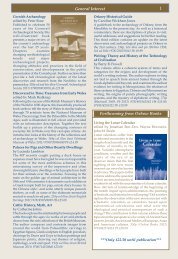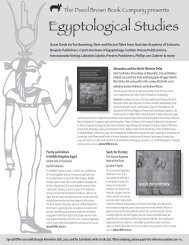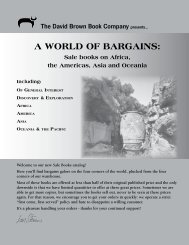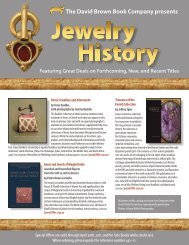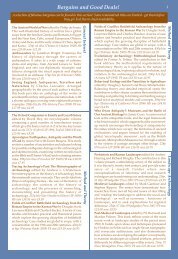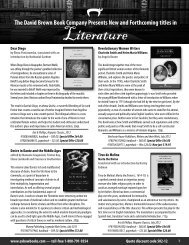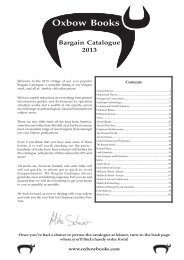Oxbow Spring 2013.pdf - Oxbow Books
Oxbow Spring 2013.pdf - Oxbow Books
Oxbow Spring 2013.pdf - Oxbow Books
You also want an ePaper? Increase the reach of your titles
YUMPU automatically turns print PDFs into web optimized ePapers that Google loves.
Mobility, Meaning and Transformation of Things<br />
Shifting Contexts of Material Culture Through Time and Space<br />
Hans Peter Hahn (Editor); Hadas Weis (Editor)<br />
Things travel around the globe: they are shipped as mass consumer goods, or<br />
transported as souvenirs or gifts. There are infinite ways for things to be mobile,<br />
not only in the era of globalisation but since the beginning of time, as the earliest<br />
traces of long distance trading show. This book investigates the mobility of<br />
things from archaeological and anthropological perspectives. Material Objects<br />
are characterised by temporal continuity, embodying a prior existence with<br />
lingering effects. Yet the material continuity disguises the transformations they<br />
may undergo, which only become evident upon closer examination. Objects are in<br />
perpetual flux, leaving visible traces of their age, usage, and previous life. While<br />
travelling through time, objects also circulate through space, and their spatial<br />
mobility alters their meaning and use with respect to new cultural horizons. As<br />
objects transform through time and space, so does the value attributed to them.<br />
Mapping out itineraries of value in the realm of the material, allows us to grasp<br />
the nature of a given social formation through the shape and meaning taken<br />
on by its valued ‘stuff’. It also provides insights into the nature of materiality,<br />
through the value ascribed to objects at a given point in time and space. This<br />
edited volume brings together studies of material culture, materiality and value,<br />
with regard to the mobility of objects, with the aim of tracing the ways in which<br />
societies constitute their valued objects and how the realm of the material<br />
reflects upon society.<br />
9781842175255, £35.00, January 2013<br />
9781842175255, £35.00, January 2013<br />
PB, 176p, b/w illus., <strong>Oxbow</strong> <strong>Books</strong><br />
PB, 176p, b/w illus., <strong>Oxbow</strong> <strong>Books</strong><br />
Method and Theory<br />
Geophysical Data in Archaeology<br />
A Guide to Good Practice<br />
Armin Schmidt (Author)<br />
Anyone who has tried to archive archaeological geophysics data will have<br />
wondered what might be the most comprehensive and practical approach. This<br />
question is addressed by this Guide’s extensively revised 2nd edition, which<br />
systematically explores what should be included in an Archive, illustrated with<br />
relevant examples. A conceptual framework is developed that allows assembling<br />
data and meta-data so that they can be deposited with an Archiving Body. This<br />
framework is also mapped onto typical database structures, including OASIS<br />
and the English Heritage Geophysics Database. Examples show step-by step<br />
how an Archive can be compiled for deposition so that readers will be able to<br />
enhance their own archiving practice. Geophysical data are sometimes the only<br />
remaining record of buried archaeological features when these are destroyed<br />
during commercial developments (e.g. road schemes). To preserve them in<br />
an Archive can therefore be essential. However, it is important that data are<br />
made available in formats that can still be read in years to come, accompanied<br />
by documentation that gives meaningful archaeological context. This Guide<br />
covers the creation of the necessary metadata and data documentation. There<br />
is no point preserving data if they cannot be used again; therefore this Guide is<br />
essential for anyone using geophysical data.<br />
4<br />
9781782971443, £15.00, February 2013<br />
PB, 88p, <strong>Oxbow</strong> <strong>Books</strong>




